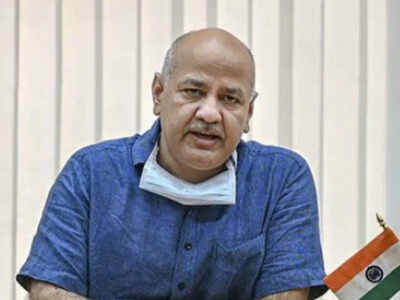Top Searches
- News
- City News
- delhi News
- As pressure eases, Manish Sisodia offers to share Delhi’s oxygen quota with others
As pressure eases, Manish Sisodia offers to share Delhi’s oxygen quota with others

Sisodia said that despite the fact that the state govt’s demand for 700 MT was met just once, Delhi govt was grateful to the interventions of the Supreme Court, Delhi HC and the Centre (ANI photo)
NEW DELHI: With Delhi witnessing a steady decline in the number of Covid-19 cases and a consistent fall in the positivity rate, deputy chief minister Manish Sisodia requested the central government on Thursday to reduce the allocation of medical oxygen to Delhi and divert it to states that might be needing the gas more than the capital.
Though Delhi faced an oxygen scarcity till recently, the decreasing Covid cases has brought a huge respite. The city recorded a positivity rate of 14.2% on Thursday, which is the lowest in a month, apart from a significant reduction in number of active cases. This has resulted in an increase in availability of oxygenated hospital beds.
At a press conference on Thursday, Sisodia said that considering the reduction in cases in Delhi and being a ‘responsible government’, he had written to the Centre requesting reduction in the allocation of oxygen to the city.
Sisodia said that Covid cases were at a peak in the last week of April and the first week of May and that on a daily basis, more than 80,000 tests were carried out, with around 27,000 returning positive results. “The positivity rate rose to 36% in that period. But now the positivity rate has reduced to around 14%, and 10,400 new cases have been recorded in the last 24 hours,” he said, adding that the oxygen demand was directly proportional to the increase in cases.
He said that because the positivity rate and hospitalised cases had reduced, the oxygen requirement had fallen. In the most intense period, Sisodia said, Delhi needed 700 MT of medical oxygen daily, but the requirement had subsequently dropped to 582 MT, as per the formula determined by the Centre.
He said the Centre should divert the surplus from Delhi’s quota to other states. Sisodia added that despite the fact that the state government’s demand for 700 MT was met just once, Delhi government was grateful to the interventions of the Supreme Court, Delhi High Court and the Centre.
He said that the interventions meant that Delhi got sufficient oxygen and saved precious lives. “During the peak period, we were getting regular distress calls on oxygen from the hospitals. Now, we receive one or two SOS calls a day, which is resolved without delay,” said the deputy CM. “Delhi government is a responsible government, so it requests the central government to reduce the daily oxygen allocation of Delhi to 582 MT and give the rest to other states.”
According to the Delhi government, the total average oxygen supply to Delhi is 579.25 MT per day, around 58% of which arrives in Delhi through roadways and 42% via the railways.
Though Delhi faced an oxygen scarcity till recently, the decreasing Covid cases has brought a huge respite. The city recorded a positivity rate of 14.2% on Thursday, which is the lowest in a month, apart from a significant reduction in number of active cases. This has resulted in an increase in availability of oxygenated hospital beds.
At a press conference on Thursday, Sisodia said that considering the reduction in cases in Delhi and being a ‘responsible government’, he had written to the Centre requesting reduction in the allocation of oxygen to the city.
Sisodia said that Covid cases were at a peak in the last week of April and the first week of May and that on a daily basis, more than 80,000 tests were carried out, with around 27,000 returning positive results. “The positivity rate rose to 36% in that period. But now the positivity rate has reduced to around 14%, and 10,400 new cases have been recorded in the last 24 hours,” he said, adding that the oxygen demand was directly proportional to the increase in cases.
He said that because the positivity rate and hospitalised cases had reduced, the oxygen requirement had fallen. In the most intense period, Sisodia said, Delhi needed 700 MT of medical oxygen daily, but the requirement had subsequently dropped to 582 MT, as per the formula determined by the Centre.
He said the Centre should divert the surplus from Delhi’s quota to other states. Sisodia added that despite the fact that the state government’s demand for 700 MT was met just once, Delhi government was grateful to the interventions of the Supreme Court, Delhi High Court and the Centre.
He said that the interventions meant that Delhi got sufficient oxygen and saved precious lives. “During the peak period, we were getting regular distress calls on oxygen from the hospitals. Now, we receive one or two SOS calls a day, which is resolved without delay,” said the deputy CM. “Delhi government is a responsible government, so it requests the central government to reduce the daily oxygen allocation of Delhi to 582 MT and give the rest to other states.”
According to the Delhi government, the total average oxygen supply to Delhi is 579.25 MT per day, around 58% of which arrives in Delhi through roadways and 42% via the railways.
FacebookTwitterLinkedinEMail
end of article
Top Stories Right Now
- indiaIndia's Covid cases fall but deaths remain high; fatality rate rises in May
- indiaIndu Jain, Times Group chairman, attains nirvana
- indiaCovid live: India reports 3,43,122 fresh cases in the last 24 hours
- indiaRole model for women aspiring to be leaders in a man’s world
- indiaUP chief minister Yogi Adityanath visits AMU after several faculty deaths
